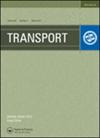弯曲轨道轮轨接触响应的动态有限元仿真
IF 1.3
4区 工程技术
Q3 TRANSPORTATION SCIENCE & TECHNOLOGY
引用次数: 1
摘要
由于在弯曲轨道上轮轨接触几何的复杂性,轮轨相互作用将会加剧。随着列车速度的增加,它也可能变得更加复杂和/或有显著的差异,因为那时的动态影响是不可忽视的。基于显式有限元软件LS-DYNA 971,建立了考虑超高程、侧倾角及应变率效应的三维弹塑性有限元模型,模拟了曲线走行过程中轮轨动态接触特性。采用接触片和压力的演变、轮轨接触力、轴的应力/应变状态和加速度对轮轨瞬态动力响应进行了分析。此外,还讨论了轴载荷、曲线半径和应变率效应的影响。曲线轨道上的最大垂直接触力、接触压力、应力和应变均随曲线半径的减小而增大,除侧向接触力外,其余均随轴载的增大而增大。在弯曲轨道上的轮轨动力响应比在直线轨道上明显增强。应变速率效应可以提高von-Mises应力和接触压力,抑制轨道和车轮的塑性变形,但对轴的垂直、侧向接触力和稳定加速度影响不大。轮轨在弯曲轨道上的速率敏感系数比在直线轨道上的要弱。这些研究结果对研究滚动接触疲劳与磨损的竞争关系以及裂纹的萌生和扩展问题具有重要的指导意义。本文章由计算机程序翻译,如有差异,请以英文原文为准。
DYNAMIC FINITE ELEMENT SIMULATION OF WHEEL–RAIL CONTACT RESPONSE FOR THE CURVED TRACK CASE
The wheel–rail interaction will be intensified on account of the complexity of the wheel–rail contact geometry on a curved track. It also may become more complicated and/or have significant difference as the train speed increases, since the dynamic effects cannot be ignored then. In this study, based on explicit Finite Element (FE) software LS-DYNA 971, a Three-Dimensional (3D) elastic-plastic FE model was built to simulate the dynamic wheel–rail contact behaviour of curve negotiating, where the superelevation and roll angle as well as the strain rate effect were considered. The evolution of contact patch and pressure, wheel–rail contact force, the stress/strain state and the acceleration of the axle were employed to examine the wheel–rail transient dynamic response. Furthermore, the influences of axle load, curve radius and strain rate effect were also discussed. It is found that the maximum vertical contact force, contact pressure, stress and strain on the curved track increase with the decreasing curve radius, and they increase with the increasing axle load except for lateral contact force. The wheel–rail dynamic responses on the curved track are significantly enhanced compared to the straight track. Moreover, the strain rate effect can enhance von-Mises stress and contact pressure, suppress the plastic deformation of the rail and wheel, but it has little effect on the vertical and lateral contact forces and stable acceleration of axle. The Rate-Sensitive Factors (RSF) of the wheel and rail on the curved track are weaker than those on the straight track. These findings will be very helpful to study the competitive relationship between the rolling contact fatigue and wear, as well as the crack initiation and propagation problem.
求助全文
通过发布文献求助,成功后即可免费获取论文全文。
去求助
来源期刊

Transport
Engineering-Mechanical Engineering
CiteScore
3.40
自引率
5.90%
发文量
19
审稿时长
4 months
期刊介绍:
At present, transport is one of the key branches playing a crucial role in the development of economy. Reliable and properly organized transport services are required for a professional performance of industry, construction and agriculture. The public mood and efficiency of work also largely depend on the valuable functions of a carefully chosen transport system. A steady increase in transportation is accompanied by growing demands for a higher quality of transport services and optimum efficiency of transport performance. Currently, joint efforts taken by the transport experts and governing institutions of the country are required to develop and enhance the performance of the national transport system conducting theoretical and empirical research.
TRANSPORT is an international peer-reviewed journal covering main aspects of transport and providing a source of information for the engineer and the applied scientist.
The journal TRANSPORT publishes articles in the fields of:
transport policy;
fundamentals of the transport system;
technology for carrying passengers and freight using road, railway, inland waterways, sea and air transport;
technology for multimodal transportation and logistics;
loading technology;
roads, railways;
airports, ports, transport terminals;
traffic safety and environment protection;
design, manufacture and exploitation of motor vehicles;
pipeline transport;
transport energetics;
fuels, lubricants and maintenance materials;
teamwork of customs and transport;
transport information technologies;
transport economics and management;
transport standards;
transport educology and history, etc.
 求助内容:
求助内容: 应助结果提醒方式:
应助结果提醒方式:


